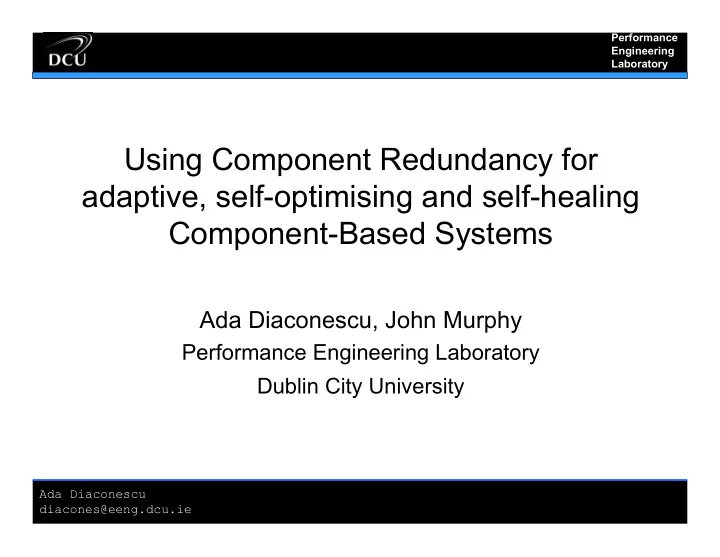

Performance Engineering Laboratory Using Component Redundancy for adaptive, self-optimising and self-healing Component-Based Systems Ada Diaconescu, John Murphy Performance Engineering Laboratory Dublin City University Ada Diaconescu diacones@eeng.dcu.ie
Performance Engineering Laboratory Main Topics • Targeted domain • Motivation • Our approach – component redundancy – What is component redundancy ? – Example – How does component redundancy work ? – Framework implementation • Conclusions & future work Using Component Redundancy for Ada Diaconescu adaptive, self-optimising and self-healing diacones@eeng.dcu.ie Component-Based Systems
Performance Engineering Laboratory Targeted domain – Enterprise software applications •We are targeting the business logic tier of enterprise software applications •Quality characteristics - influenced by all tiers and layers involved Using Component Redundancy for Ada Diaconescu adaptive, self-optimising and self-healing diacones@eeng.dcu.ie Component-Based Systems
Performance Engineering Laboratory Motivation • Enterprise software applications - Characteristics: – Complex, large-scale – Highly distributed and parallel – Non-real time, Soft quality requirements (performance, reliability) ⇒ Complicated & expensive design, testing, management processes ⇒ Reduced flexibility ⇒ Quality characteristics hard to control • Component-Based Software Development (CBSD): – Benefits: modularity, reuse, shorter development time, lower costs – New challenges: lack of information • At component development: ?overall system, platform, resources? • At system integration: ?component insight information, changing resources/ requirements at runtime? • Impossible to exhaustively test such software apps. offline Using Component Redundancy for Ada Diaconescu adaptive, self-optimising and self-healing diacones@eeng.dcu.ie Component-Based Systems
Performance Engineering Laboratory Component redundancy – what is ? • Multiple Software Component Variants, with: – Identical interfaces, Equivalent functionalities (i.e. offered services) and – Different design and/or implementation strategies are available at run-time • Only one component variant is active at all times Delegate Request to Improved Performance Poor Performance Active component variant __- instantiated for handling client requests - Redundancy Group • Variants are used alternatively, Component Component Component Variant 1 Variant 1 Variant 1 ‘complementing’ each other P r o x y Component Component Variant 2 Variant 2 • Variants are replaced in case of: Request Service Component •Poor/ non-optimal performance Variant 3 •Fault detection Redirect Requests to •Changing requirements, or running-context Component Variant 2 Using Component Redundancy for Ada Diaconescu adaptive, self-optimising and self-healing diacones@eeng.dcu.ie Component-Based Systems
Performance Engineering Laboratory Example • Used EJB component technology • Two component implementations: – Same functionality: retrieve information from a remote DB – Different design: Direct DB vs. Using Entity Bean Response-time variations with Network load on the link to the DB ⇒ Alternating variants yields better performance, at all times Using Component Redundancy for Ada Diaconescu adaptive, self-optimising and self-healing diacones@eeng.dcu.ie Component-Based Systems
Performance Engineering Laboratory Component redundancy – how it works Monitoring Evaluation Action (&testing) •Determine optimal variant(s) •Use: •Monitor application •Activate /deactivate •Monitoring info •Monitor environment component variants •Descriptions •Determine problems: •Maintain application •Decision policies •Causes integrity •Update descriptions •Affected components •Update decision policies C1.1 C1.1 C1.1 C2.1 C3.1 C1.2 C3.2 C1.2 C2.2 C1.3 C3.3 C2.3 C5.1 C4.1 C5.2 Application Server / Container Functional Application Using Component Redundancy for Ada Diaconescu adaptive, self-optimising and self-healing diacones@eeng.dcu.ie Component-Based Systems
Performance Engineering Laboratory Distributed adaptation mechanism • Motivation: centralised adaptation mechanisms might: – Introduce unnecessary overhead – Not scale well • Adaptation mechanisms with different scopes: – Component – Group of components – Entire application • Hierarchical organisation • Local problems: – Initially dealt with locally – Signalled to higher level adaptation mechanisms (if necessary) • Periodic global optimisations Using Component Redundancy for Ada Diaconescu adaptive, self-optimising and self-healing diacones@eeng.dcu.ie Component-Based Systems
Performance Engineering Laboratory Framework Implementation • Independent of specific applications • Two options: a) Distributed platform level b) Software application level • Maintain application integrity: - Component swapping implemented by means of client call indirection • No state transfer • Keep client references consistent using the proxy pattern Using Component Redundancy for Ada Diaconescu adaptive, self-optimising and self-healing diacones@eeng.dcu.ie Component-Based Systems
Performance Engineering Laboratory Conclusions & future work • Component-based enterprise software • Difficult to provide and maintain performance and dependability: – Lack of information – Changing requirements and execution contexts • Our approach: using component redundancy (overview, general framework) • Expected benefits: • Automatic performance optimisation • Recover from and avoid integration faults • Adapt to changing requirements, resources, workloads • Future work: • Identify and implement relevant examples • Design and implement proof-of-concept framework • Identify and integrate work on monitoring, component descriptions, knowledge based management,… Using Component Redundancy for Ada Diaconescu adaptive, self-optimising and self-healing diacones@eeng.dcu.ie Component-Based Systems
Performance Engineering Laboratory Using Component Redundancy for Ada Diaconescu adaptive, self-optimising and self-healing diacones@eeng.dcu.ie Component-Based Systems
Recommend
More recommend